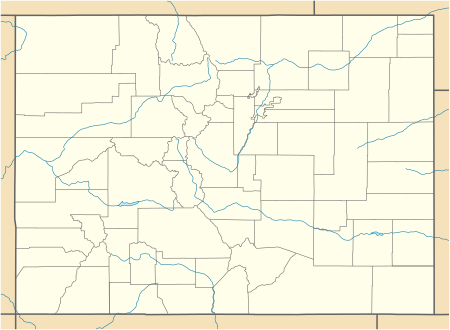San Juan volcanic field
| San Juan volcanic field | |
|---|---|
 San Juan volcanic field Location in Colorado | |
| Highest point | |
| Coordinates | 37°53′36″N 106°46′28″W / 37.89333°N 106.77444°WCoordinates: 37°53′36″N 106°46′28″W / 37.89333°N 106.77444°W |
| Geography | |
| Location | Colorado, United States |
| Geology | |
| Mountain type | Volcanic field |
The San Juan volcanic field is part of the San Juan Mountains in southwestern Colorado. It consists mainly of volcanic rocks that form the largest remnant of a major composite volcanic field that covered most of the southern Rocky Mountains in the Middle Tertiary geologic time.[1] Within the region lie an abundance of caldera volcanoes, which comprise the San Juan Volcanic Fields. There are approximately 15 calderas known in the San Juan Volcanic Fields; however, it is possible that there are 2, or even 3 more in the region.[1]
The region began with many composite volcanoes that became active between 35 and 40 million years ago and were particularly eruptive in the time period around 35-30 million years ago.[1] Around this time the activity changed to explosive ash-flow eruptions.[2] Many of these volcanoes experienced caldera collapse, resulting in the 15-18 caldera volcanoes in the region today.[1]
Phases of Volcanism
The San Juan volcanic field contains two phases of volcanism.
The earlier volcanism is from the Oligocene age of the Paleogene Period. It consists of largely intermediate composition lavas and breccias. A few ash flow tuffs also constitute this phase of volcanism.
The later volcanism is from the Miocene to Pliocene in ages of the Neogene Period. It is basaltic in composition. It is usually interpreted as a partial melt of the lower crust that was erupted onto the surface.[3]
.jpg)
Notable calderas
- La Garita Caldera, size: 35 x 75 km.[4] The La Garita caldera was formed by one of the most explosive and energetic eruptions in earth's history. This eruption, which occurred about 26.3 million years ago, spewed more than 3,107 cubic miles (5,000 cubic km) of lava from its rim.[5] To this day it is the only known eruption to reach a 9 on the VEI scale.[5]
- La Garita, North Caldera (Saguache) 37°57′N 106°48′W / 37.95°N 106.8°W
- La Garita, Central Caldera 37°45′34″N 106°56′20″W / 37.759316°N 106.938858°W
- La Garita, South Caldera 37°34′N 107°00′W / 37.56°N 107°W
| Name | Elevation | Coordinates | Age |
| Cochetopa Caldera | - | 38°12′N 106°45′W / 38.2°N 106.75°W[4] | |
| Bonanza Caldera | - | 38°19′13″N 106°04′44″W / 38.320333°N 106.078833°W[6] | 33.12 ± 0.03 Ma |
| Nelson Mountain Caldera | - | 37°58′N 106°56′W / 37.96°N 106.93°W[4] | |
| Bachelor Caldera | - | 37°49′03″N 106°54′46″W / 37.817378°N 106.912766°W[4] | |
| Creede Caldera | - | 37°45′34″N 106°56′20″W / 37.759316°N 106.938858°W[4] | |
| Lake City calderas | - | 38°01′31″N 107°23′04″W / 38.025377°N 107.384491°W[3] | |
| Platoro calderas | - | 37°21′08″N 106°31′52″W / 37.352147°N 106.530991°W[3] |
.jpg)
See also
- List of large volume volcanic eruptions in the Basin and Range Province
- San Juan Mountains (Colorado)
- Volcanic fields of Colorado
References
- 1 2 3 4 Steven, Thomas A.; Lipman, Peter W. (1976). "Calderas of the San Juan Volcanic Field, Southwestern Colorado". U.S. Geological Survey Professional Papers. Washington, DC: U.S. Government Printing Office. 958: 1–35. Retrieved 2012-05-16.
- ↑ Lipman, Peter W.; Steven, Thomas A.; Mehnert, Harald H. (1970-08-01). "Volcanic History of the San Juan Mountains, Colorado, as Indicated by Potassium–Argon Dating". Geological Society of America Bulletin. 81 (8): 2329–2352. doi:10.1130/0016-7606(1970)81[2329:VHOTSJ]2.0.CO;2. ISSN 0016-7606.
- 1 2 3 Lipman, P.W.; Doe, B.R.; Hedge, C.E.; Steven, T.A. (1978). "Petrologic evolution of the San Juan volcanic field, southwestern Colorado: Pb and Sr isotope evidence". Geological Society of America Bulletin. 89: 59–82. doi:10.1130/0016-7606(1978)89<59:PEOTSJ>2.0.CO;2. ISSN 0016-7606.
- 1 2 3 4 5 Robinson, Joel E.; Dillon R. Dutton; David W. Ramsey; Peter W. Lipman; Tracey J. Felger (2006). Geologic Map of the Central San Juan Caldera Cluster, Southwestern Colorado: Geologic Investigations Series. I-2799. U.S. Geological Survey. Retrieved 2010-05-03.
- 1 2 "What's the Biggest Volcanic Eruption Ever?". Live Science. Retrieved 2016-10-23.
- ↑ Lipman, Peter W.; Zimmerer, Matthew J.; McIntosh, William J. (2015-12-01). "An ignimbrite caldera from the bottom up: Exhumed floor and fill of the resurgent Bonanza caldera, Southern Rocky Mountain volcanic field, Colorado". Geosphere. 11 (6): 1902–1947. doi:10.1130/GES01184.1. Retrieved 2017-11-01.